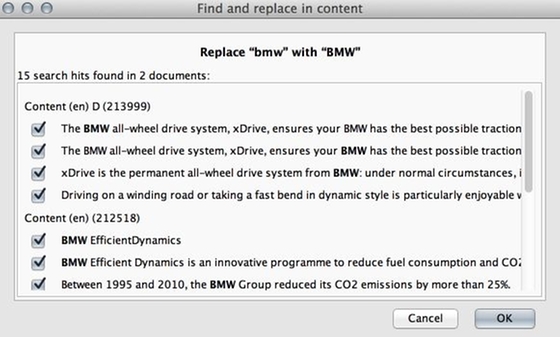With censhare, companies can keep control of large content projects like books on the basis of XML or Adobe's InCopy. With Version 4.8, text which is distributed over many content assets can easily be changed in one pass with search and replace.
Mastering demanding textbooks
In particular with textbooks, content projects may acquire great complexity. For this reason the text is usually distributed across many different files in XML or Adobe InCopy format. XML is an obvious choice for linking prose elements and structured information in some text, for example with travel guides or technical books. censhare can handle both formats. This also includes simple modifications to text. To accomplish this, censhare 4.8 introduces search and replace across the entire project or particular parts of a project. The search area may be constrained very precisely to particular content areas of a project.
If book projects, for instance, work with structured assets such as interesting sights, censhare offers a further possibility to change contents globally. censhare stores the information assets centrally. The XML text contains only a pointer to the particular entry. If, for instance, the opening times are changed, these are corrected centrally. For the next book production, censhare fetches this information and inserts it in place of the link.
The use of XML allows book production to be partially automated. The updating of a travel guide when information changes, for instance, thereby requires much less time. The text on sites of interest no longer needs to be manually looked through in order to change the information.
In addition censhare offers the framework, for instance with workflows, for managing the revision of large content projects which involve many people at different sites.
Customer benefits
- Many possibilities for automation with XML for the publication of books in a topical series
- Creation of the entire content in XML or ICML
- Use of XML content in various books, for example legal texts
- Working with Content-in-Content structures: insertion of information objects in XML text with Drag & Drop
- Simple content changing with central storage of information objects
- Simple changing of information with search and replace in the whole XML or ICML content
- Individual definition of the search area by means of search XSLTs, adapted for the particular project
Application case
- Production of large book projects with a great deal of detailed information as with textbooks on travel, health or engineering themes
- Production of book projects for different channels such as print or E-book
- Distributed working of many specialist authors, editors, and layout experts on a joint book project
- Updating of information objects (such as entrance prices or opening times) in all books in one step
- Changing of a designation such as a product name in all XML or ICML files of a content project in one step
XML ensures flexibility
The basis for maximal automation of content production, such as for books, is XML or ICML, Adobe's XML format for InCopy. With XML, data may be captured in fine detail, down to the opening times of an interesting sight. Even if the text is intended to appear more than once in different books, it only has to be recorded once with XML. Thanks to XML, different variants and information may be captured and evaluated or suppressed specially for the particular edition. It is also very simple to generate contents, keyword or illustration lists specifically for a particular book.
Book projects may be very extensive and the text may be distributed over many files. With censhare 4.8, changes can still be performed quickly with search and replace. There is no need to open the content asset manually. The user selects the search area from a list of choices. This may be the whole book, particular chapters or some other appropriately defined area. Its definition takes place in the framework of an introductory project with the help of search XSLTs (XSL Transformations).
The user sees and processes the results of the search in a special dialog window. They are grouped by the individual content assets. If particular instances should not be changed, the user removes the tick from those particular instance. censhare stores the modified assets as a new version.
Flexible search function for XML content
"Search and Replace in Content" is available as a server action. The search area is defined with an XSLT resources asset. If more than one search XSLTs is available, the user can select the desired area in the search and replace dialog.
For this, every search XSLT must be stored in censhare as a resource asset and possess the key "censhare:search-and-replace-content-search". The user must also configure the asset's metadata for use in "Search and Replace in Content“. The search XSLT defines, based on the marked asset, which content assets of the particular asset structure are included in the search.
After the search, the function indicates all instances it has found in the search area, ordered by content asset. The user can now decide for each instance whether it should be changed. If another user has opened a content asset with instances found, these can neither be selected nor modified. Subsequently the function (Check-out) opens the assets with selected instances, modifies these and saves the assets again (Check-in).




